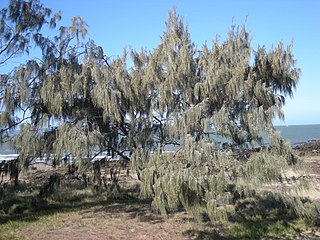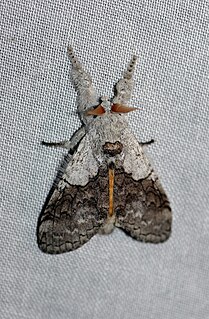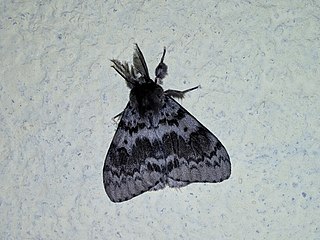
Casuarina equisetifolia, the Australian pine tree or whistling pine tree, is a she-oak species of the genus Casuarina. The native range extends throughout Southeast Asia, Northern Australia and the Pacific Islands; including Thailand, Myanmar, Vietnam, Malaysia, Singapore, Brunei, Indonesia, East Timor, and the Philippines, east to Papua New Guinea, French Polynesia, New Caledonia, and Vanuatu, and south to Australia. Populations are also found in Madagascar, but it is doubtful if this is within the native range of the species. The species has been introduced to the Southern United States and West Africa. It is an invasive species in Florida, South Africa, India and Brazil.

Casuarina is a genus of 17 tree species in the family Casuarinaceae, native to Australia, the Indian subcontinent, southeast Asia, islands of the western Pacific Ocean, and eastern Africa. It was once treated as the sole genus in the family, but has been split into four genera.

Lymantria is a genus of tussock moths in the family Erebidae. They are widely distributed throughout Europe, Japan, India, Sri Lanka, Myanmar, Java, and Celebes. The genus was erected by Jacob Hübner in 1819.

Lymantria xylina, the casuarina moth or casuarina tussock moth, is a moth in the family Erebidae. The species was first described by Charles Swinhoe in 1903. It is found in Japan, Taiwan and the Chinese provinces of Fujian and Guangdong.
Chilena strigula is a moth of the family Lasiocampidae first described by Francis Walker in 1865. It is found in India and Sri Lanka. Caterpillars are known to feed on Acacia species.
Aroa plana is a moth of the family Erebidae first described by Francis Walker in 1855. It is found in India and Sri Lanka. The caterpillar is known to feed on Bambusa species.

Calliteara horsfieldii, or Horsfield's tussock moth, is a moth of the family Erebidae. The species was first described by Saunders in 1851.
Casama vilis is a moth of the family Erebidae first described by Francis Walker in 1865. It is found in Sri Lanka, India, Middle East, Ethiopia, Kenya and Somalia.
Lacida costalis is a moth of the family Erebidae first described by Francis Walker in 1855. It is found in Sri Lanka.
Euproctis bimaculata is a moth of the family Erebidae first described by Francis Walker in 1855. It is found in India, Sri Lanka and Thailand.
Nygmia xanthomela is a moth of the family Erebidae first described by Francis Walker in 1862. It is found in Sri Lanka, Borneo, Java, Sumatra and Peninsular Malaysia.

Lymantria ampla is a moth of the family Erebidae first described by Francis Walker in 1855. It is found in India and Sri Lanka.
Lymantria grandis is a moth of the family Erebidae first described by Francis Walker in 1855. It is found in Sri Lanka.

Lymantria incerta is a moth of the family Erebidae first described by Francis Walker in 1855. It is found in India and Sri Lanka.
Lymantria marginata is a moth of the family Erebidae first described by Francis Walker in 1855. It is found in India, Bangladesh, Sri Lanka and Thailand.
Lymantria subrosea is a moth of the family Erebidae first described by Francis Walker in 1855. It is found from Sri Lanka to China and Sundaland, the Philippines, Sulawesi, Seram, the Lesser Sundas to Timor. The Sumatran population is categorized under the subspecies, Lymantria subrosea singapura.
Lymantria todara is a moth of the family Erebidae first described by Moore in 1879. It is found in India (Nilgiri) and Sri Lanka.

Cleora alienaria is a moth of the family Geometridae first described by Francis Walker in 1860. It is found in Sri Lanka, the Indian subregion to the Andaman Islands, Thailand, Sundaland, Taiwan, and Lesser Sundas as far east as Timor and Christmas Island.
Cyclophora nebulosata is a moth of the family Geometridae first described by Francis Walker in 1862. It is found in Sri Lanka.
Synegia imitaria is a moth of the family Geometridae first described by Francis Walker in 1861. It is found in Sri Lanka, India, Borneo, Peninsular Malaysia and Sumatra.







